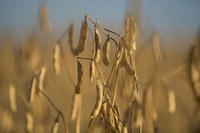NDSU Offers Soybean Drying Advice
(Click the image below to view a high-resolution image that can be downloaded)
A challenging soybean harvest is raising many storage and drying questions, according to Ken Hellevang, agricultural engineer with North Dakota State University Extension.
Soybeans at 11 percent moisture have similar storage characteristics as wheat or corn at about 13.5 percent moisture, so 16 percent moisture soybeans might be expected to store the same way as about 19 percent moisture corn.
“It is important to be able to aerate the soybeans to keep them cool,” Hellevang says.
The amount of natural air drying that will occur in late October and early November is limited. The equilibrium moisture content of soybeans for air at 40 degrees and 70 percent relative humidity is about 12 percent, so drying soybeans above 12 percent would be expected with this air condition.
However, the drying rate will be slow at typical in-bin drying airflow rates. An airflow rate of 1 cubic foot per minute per bushel (cfm/bu) is expected to dry 18 percent moisture soybeans in about 60 days. With an airflow rate of 1.5 cfm/bu, the drying time is reduced to about 40 days.
The drying time for 16 percent moisture soybeans is slightly less - about 50 days. Adding supplemental heat to raise the air temperature by 3 to 5 degrees will permit drying the soybeans to about 11 percent moisture in about 40 to 45 days. Increasing the airflow rate proportionally reduces the drying time.
The moisture-holding capacity of air is reduced at lower air temperatures, Hellevang says. As average air temperatures approach 35 degrees, natural air drying becomes inefficient and not economical. Adding heat would cause the beans on the bottom of the bin to dry to a lower moisture content, and it would increase drying speed only slightly.
Hellevang recommends cooling the soybeans to between 20 and 30 degrees for winter storage and completing the drying in the spring. Start drying in the spring when outdoor temperatures are averaging about 40 degrees.
Increasing the airflow rate will increase the drying speed. However, the fan horsepower required to achieve the higher airflow rate becomes excessive unless the grain depth is very shallow.
For a soybean depth of 22 feet, each 1,000 bushels of soybeans will require about 1 horsepower of fan. To achieve an airflow rate of 1.25 cfm/bu will require about 1.6 horsepower per 1,000 bushels and an airflow rate of 1.5 cfm/bu will need about 2.5 horsepower per 1,000 bushels.
“The type of fan greatly affects the airflow provided per horsepower, so use a fan selection software program such as the one developed by the University of Minnesota,” Hellevang advises. “It is available on the NDSU grain drying and storage website. To find the website, do an internet search for NDSU grain drying and storage.”
Soybeans can be dried in a high-temperature dryer, but the dryer temperature needs to be limited to minimize damage to the beans. Refer to the manufacturer’s recommendations for maximum drying temperature.
Typically, the maximum drying temperature for nonfood soybeans is about 130 degrees. Even at that temperature, some skins and beans will be cracked.
One study found that with a dryer temperature of 130 degrees, 50 to 90 percent of the skins were cracked and 20 to 70 percent of the beans were cracked. Another study found that 30 percent of the seed coats were cracked if the drying air relative humidity was 30 percent.
Roughly, with each 20 degree increase in drying temperature, the air relative humidity is reduced to one-half, Hellevang notes. Air at 50 degrees and 80 percent relative humidity will have a relative humidity of about 40 percent when heated to 70 degrees. He recommends monitoring the soybean seeds coming from the dryer and managing the dryer temperature based on the amount of damage occurring.
Hellevang also warns of the risk of fires when drying soybeans. Soybean pods and other trash can accumulate in the dryer and combust. He has this advice to reduce the risk of fires:
- Assure that trash does not accumulate in the dryer.
- Assure that the soybeans continue to flow in all sections of the dryer.
- Monitor the dryer continuously.
- Clean the dryer frequently to reduce the potential for debris to combust.
NDSU Agriculture Communication - Oct. 12, 2018
| Source: | Ken Hellevang, 701-231-7243, kenneth.hellevang@ndsu.edu |
|---|---|
| Editor: | Ellen Crawford, 701-231-5391, ellen.crawford@ndsu.edu |


